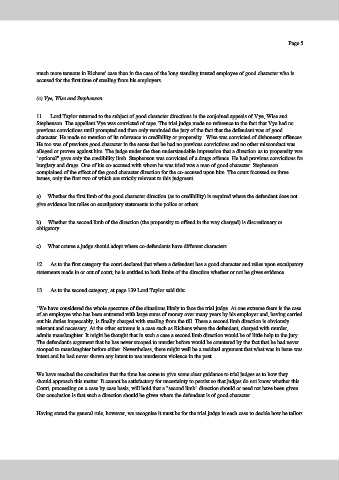Page 412 - Magistrates Conference 2019
P. 412
Page 5
much more tenuous in Richens' case than in the case of the long standing trusted employee of good character who is
accused for the first time of stealing from his employers.
(c) Vye, Wise and Stephenson
11. Lord Taylor returned to the subject of good character directions in the conjoined appeals of Vye, Wise and
Stephenson. The appellant Vye was convicted of rape. The trial judge made no reference to the fact that Vye had no
previous convictions until prompted and then only reminded the jury of the fact that the defendant was of good
character. He made no mention of its relevance to credibility or propensity. Wise was convicted of dishonesty offences.
He too was of previous good character in the sense that he had no previous convictions and no other misconduct was
alleged or proven against him. The judge under the then understandable impression that a direction as to propensity was
"optional" gave only the credibility limb. Stephenson was convicted of a drugs offence. He had previous convictions for
burglary and drugs. One of his co-accused with whom he was tried was a man of good character. Stephenson
complained of the effect of the good character direction for the co-accused upon him. The court focussed on three
issues, only the first two of which are strictly relevant to this judgment.
a) Whether the first limb of the good character direction (as to credibility) is required where the defendant does not
give evidence but relies on exculpatory statements to the police or others.
b) Whether the second limb of the direction (the propensity to offend in the way charged) is discretionary or
obligatory.
c) What course a judge should adopt where co-defendants have different characters.
12. As to the first category the court declared that where a defendant has a good character and relies upon exculpatory
statements made in or out of court, he is entitled to both limbs of the direction whether or not he gives evidence.
13. As to the second category, at page 139 Lord Taylor said this:
"We have considered the whole spectrum of the situations likely to face the trial judge. At one extreme there is the case
of an employee who has been entrusted with large sums of money over many years by his employer and, having carried
out his duties impeccably, is finally charged with stealing from the till. There a second limb direction is obviously
relevant and necessary. At the other extreme is a case such as Richens where the defendant, charged with murder,
admits manslaughter. It might be thought that in such a case a second limb direction would be of little help to the jury.
The defendant's argument that he has never stooped to murder before would be countered by the fact that he had never
stooped to manslaughter before either. Nevertheless, there might well be a residual argument that what was in issue was
intent and he had never shown any intent to use murderous violence in the past.
We have reached the conclusion that the time has come to give some clear guidance to trial judges as to how they
should approach this matter. It cannot be satisfactory for uncertainty to persist so that judges do not know whether this
Court, proceeding on a case by case basis, will hold that a "second limb" direction should or need not have been given.
Our conclusion is that such a direction should be given where the defendant is of good character...
Having stated the general rule, however, we recognise it must be for the trial judge in each case to decide how he tailors

